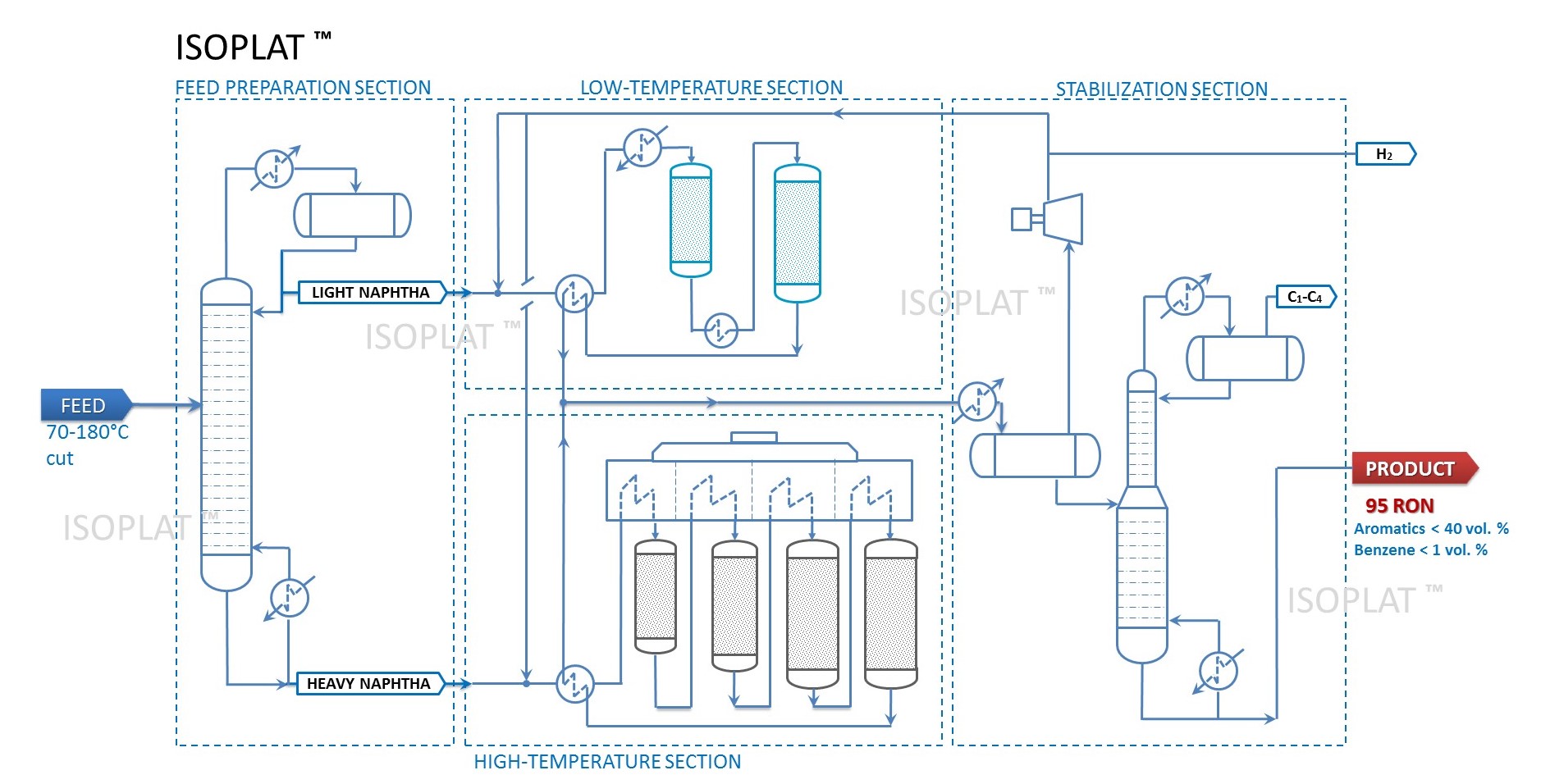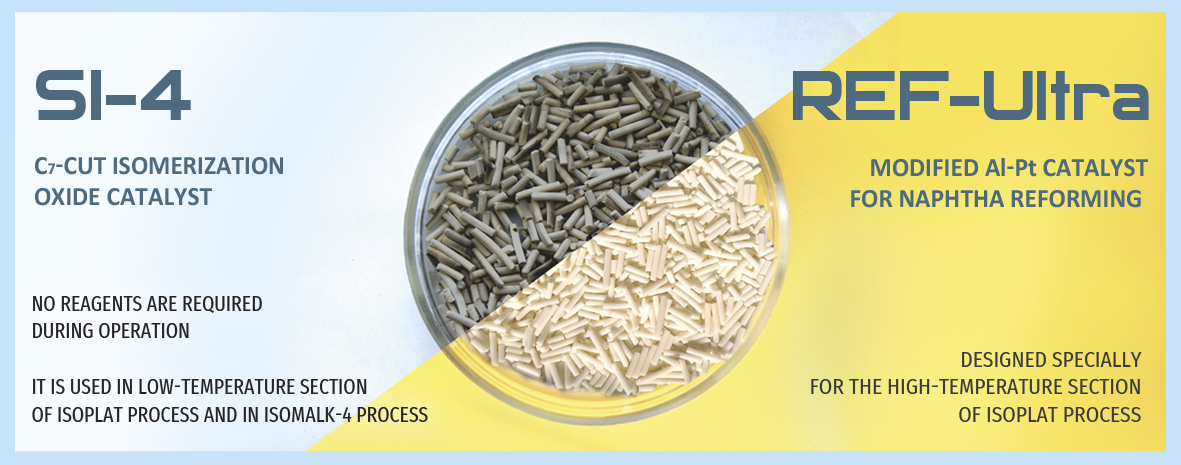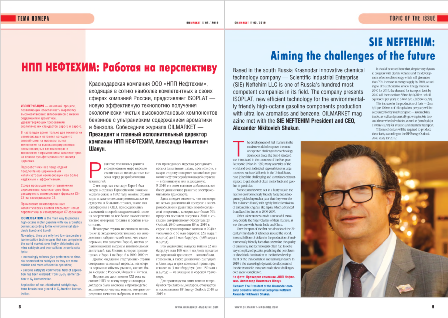ISOPLAT Process
Effective Production of Ultra-low Aromatics Gasoline
Today in most countries of the world there are standards for motor gasoline that provide for a low content of aromatics, at a level not exceeding 35% vol., including benzene - at a maximum of 1% vol.
The ISOPLAT technology developed by SIE Neftehim, LLC, is designed for processing 70-180°C hydrocarbon cut into the main component of motor gasoline with a low content of aromatics, benzene, and with an octane number higher than 95 points.
The resulting product also meets all applicable standards for the content of trace impurities in motor gasoline in accordance with TR CU 013/2011 and EN 228 standards.
ISOPLAT Technology Application
The technology may be introduced using the standard process equipment without any additional licenses.
70-180°С feed cut is first separated in a feed pre-treatment column into two cuts: 70-110°С (light naphtha) and 110-180°С (heavy naphtha). Then, after mixing with hydrogen gas stream, the light and heavy cuts are sent to low-temperature and high-temperature reactor sections, respectively.
- LOW-TEMPERATURE REACTION SECTION of ISOPLAT unit includes 1 or 2 reactors, heaters, and heat-exchangers. In this section reactors, light naphtha undergoes the isomerization process based on the oxide non-chlorinated catalyst SI-4 producing the high-octane unstable isomerate. The product in this section is aromatics free.
- HIGH-TEMPERATURE REACTION SECTION of ISOPLAT unit includes 4 reactors in series, common convectional gas furnace, heat exchangers. In high-temperature section reactors, the reactions of dehydrogenation of six-membered naphthenes and dehydroisomerization of five-membered naphthenes, paraffin dehydrocyclization, isomerization of five and six-membered naphthenes, paraffins and aromatic hydrocarbons occur over a special catalyst REF-Ultra.
Reaction products from the two sections are mixed and sent first to a separator to recover hydrogen gas, and then to Stabilizer section to remove light hydrocarbons and dissolved hydrogen from the product.
PRODUCT of ISOPLAT unit with RON 95 and low aromatics is recovered from the unit directly to storage.
All the technical and design solutions are well proven in the industry, which makes the process implementation much easier, while project implementation period is substantially reduced.
ISOPLAT process diagram is presented below:

ISOPLAT technology is suitable for introduction both as a grass root, as well as through revamp and retrofitting the existing fixed-bed reforming facilities.
ISOLPAT process catalysts

SI-4 catalyst
The low-temperature section operation is based on the oxide catalyst for С7 hydrocarbons isomerization extraordinary in its activity and selectivity.
SI-4 catalyst features:
- High selectivity in С7 paraffin isomerization process;
- No reagents are required during operation;
- High stability and tolerance to catalytic poisons;
- Ensures selective process of heptane isomerization at the temperatures starting with 160°C;
- Catalyst service life is 10 years;
- Regeneration in-situ.
REF-Ultra catalyst
Modified Al-Pt reforming catalyst REF-Ultra is specifically designed by SIE Neftehim, LLC for severe mode operation with maximum yield of high-octane reformate.
REF-Ultra catalyst features:
- Reformate octane is up to 99 numbers;
- High yield of the target product — 86-88 vol. %;
- High process stability and selectivity;
- Long service cycle between regenerations — from 20 to 48 months;
- Long service life — more than 8 years.

ISOPLAT™ Unit Construction
To implement the grass-root ISOPLAT unit project, the following will be required:
- Inspection of existing facilities;
- ISOPLAT process feasibility study;
- Decision-making and Kick-off meeting of all the parties involved;
- Development of Basic Engineering Design Package containing all basic estimations and process mandatory requirements;
- Detailed Engineering Design made by a qualified design contractor engaged by SIE Neftehim or a customer/investor;
- Equipment ordering;
- Construction;
- Training of personnel in unit operating practices and skills;
- Catalyst supply;
- Pre-commissioning;
- Start of target product manufacturing.
Usually, the grass-root construction takes from 24 to 36 months.
Skilled experts of SIE Neftehim render support at all the project stages, monitor current operation of a unit and provide recommendations on enhancing the performances, if necessary.
SIE Neftehim always promptly provides consulting and technical assistance in handling current production challenges.
SIE Neftehim experts are ready to provide prompt consultations and determine performances based on the actual refinery feed and capabilities.
For consultations, please use our Feedback form. We will certainly reply to you. Please do not forget to provide your contact information.
Additional materials to the article:
SIE NEFTEHIM: Aiming the challenges of the future
Article in a monthly trade magazine OilMarket (2019-No.2)
Full list of SIE Neftehim publications in print media
See also:
Combined processing of IBP-180 fraction
Heptane isomerization technology Isomalk-4
Pentane-hexane fraction isomerization technology Isomalk-2
All rights reserved. This article has been prepared with the sole purpose of informing SIE Neftehim, LLC clients about the most up-to-date developments and cannot be used for any other purposes.











